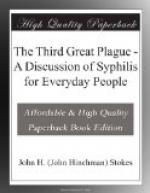+Destructive Changes, Bones, Teeth, Etc.+—Syphilis in children, since it is essentially late syphilis, may produce gummatous changes of the most disfiguring type, fully as extreme as those in acquired syphilis and resulting in the destruction or injury of important organs, and the loss of parts of bones, especially about the mouth and nose. Certain changes in the teeth, especially the upper incisors in the second set, are frequent in hereditarily syphilitic children, but do not always occur. These peg-shaped teeth are called Hutchinson’s teeth. Individuals with hereditary syphilis who survive the early years of life are less likely to develop trouble with the heart, blood vessels, or nervous system than are those with acquired syphilis.
+Eye Trouble—Interstitial Keratitis.+—Two manifestations of hereditary syphilis are of obvious social importance. One of these is the peculiar form of eye trouble which such children may develop. It is known as interstitial keratitis, and takes the form of a gradual, slow clouding of the clear, transparent convex surface of the eyeball, the cornea, through which the light passes to reach the lens. While the process is active, the child is made miserable by an extreme sensitiveness to light, the eye is reddened, and there is pain and a burning sensation. When the condition passes off, the child may scarcely be able to distinguish light from dark, to say nothing of reading, finding its way about, or doing fine work. A certain amount of the damage, once done, cannot be repaired, although cases improve surprisingly if the process is still active and is properly treated. The course is slow, often a matter of years, and only too many patients do very poorly on the sort of care they can get at home. One eye case in every 180 has interstitial keratitis, according to reliable figures.[9] Of 152 with this trouble, only 60 per cent recovered




